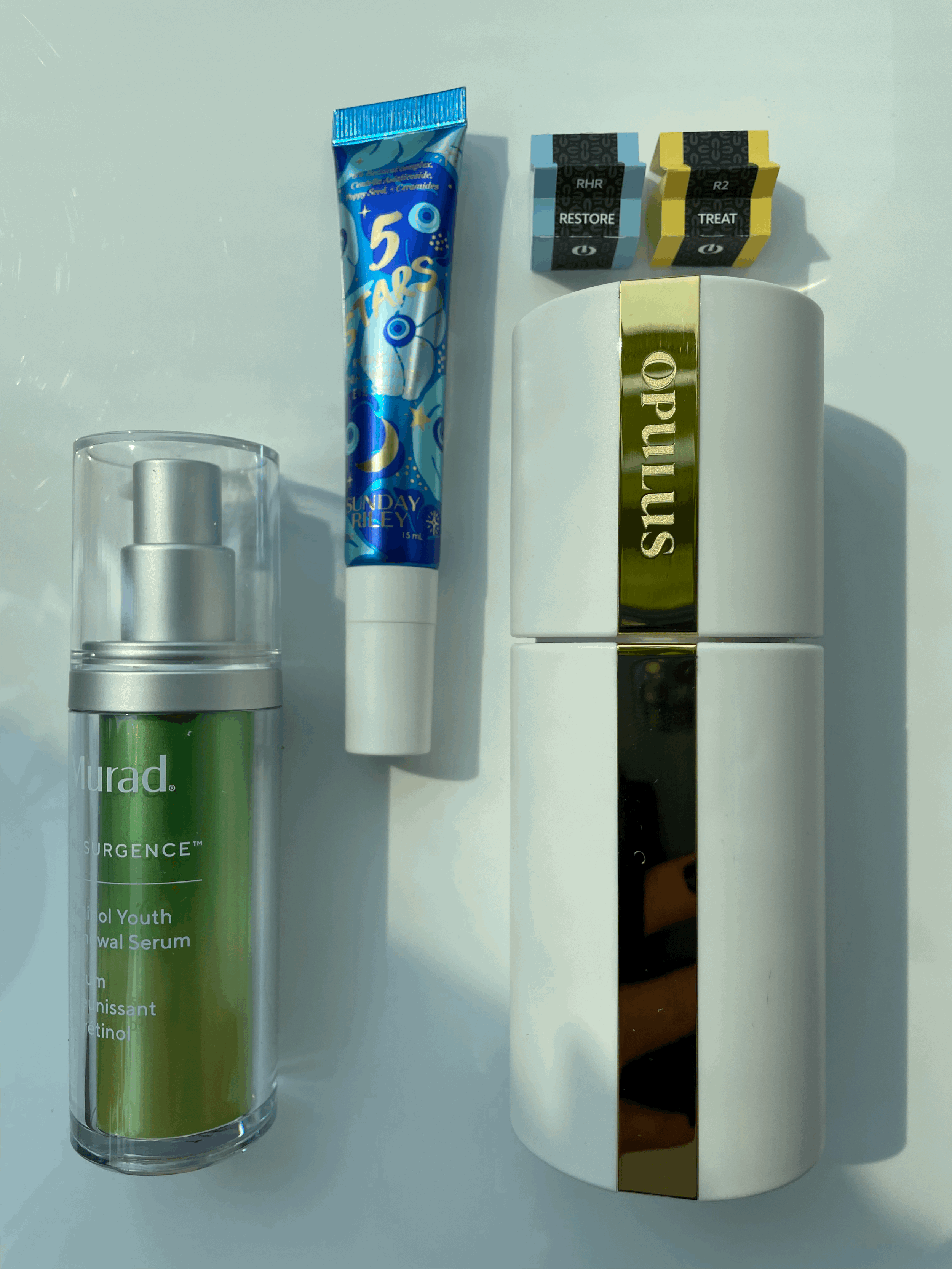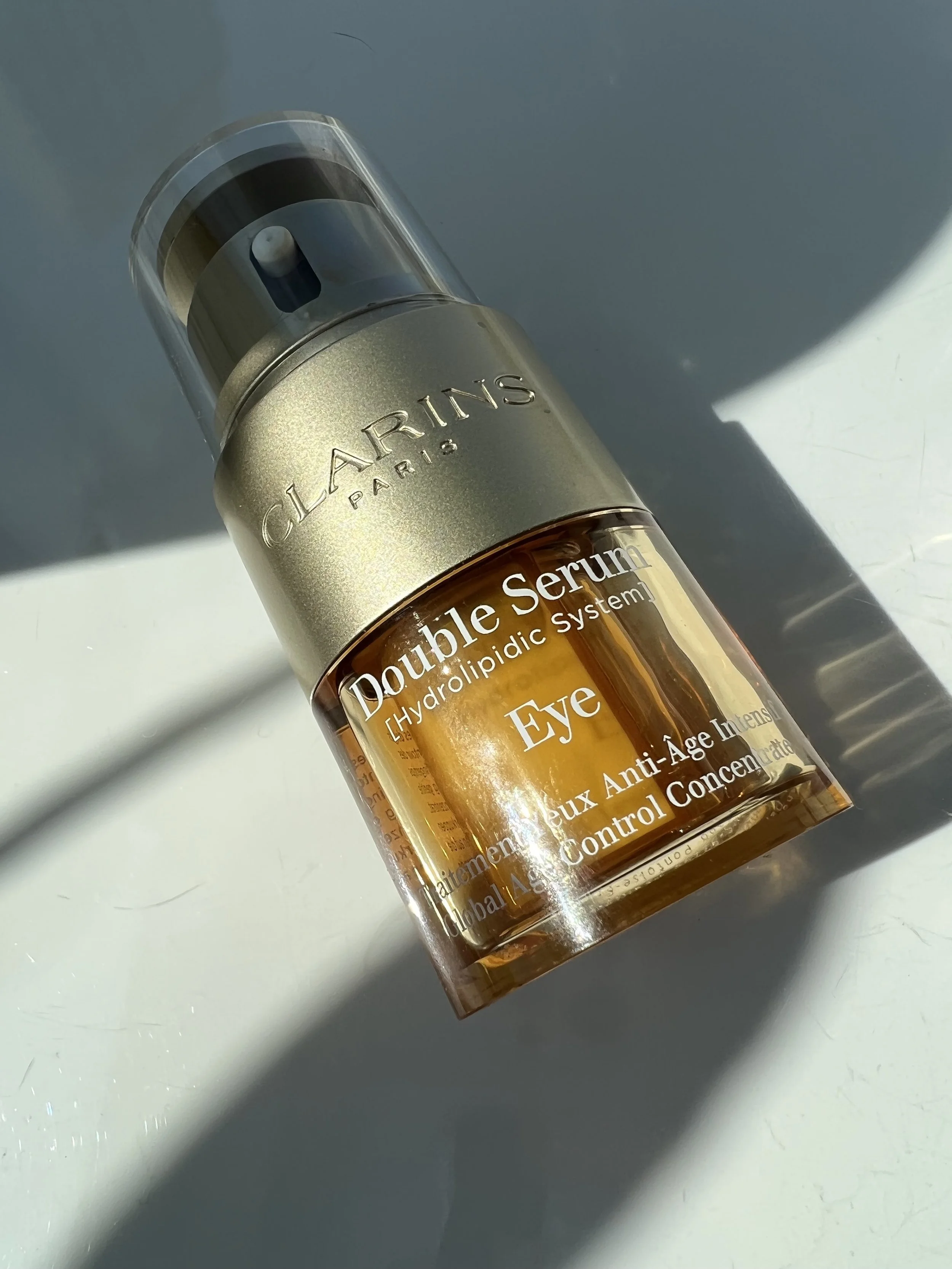PRODUCT REVIEW: SUNDAY RILEY 5 STARS RETINOID + NIACINAMIDE EYE SERUM – BEST EYE CREAM WITH RETINOL, BEST BRIGHTENING EYE CREAM FOR DARK CIRCLES
SUNDAY RILEY | 5 STARS RETINOID + NIACINAMIDE EYE SERUM
I first featured this superb eye cream with Retinol from Sunday Riley on #skincarmasaturda — when I share a glimpse of my new skincare discoveries of the week. It was part of a collection of new Retinol products that included the Murad
Retinol Youth Renewal Serum and the Opulus Beauty Labs fresh-activated Retinol system, perhaps the most innovative Retinol treatment on the market today.
I’m a fan of so many Sunday Riley products, including the brand’s the Sunday Riley Good Genes All-In-One Lactic Acid Treatment — one of the best daily exfoliating serums with Lactic Acid. And, while I’m not a fan of the orange scent of Sunday Riley’s C.E.O. 15% Vitamin C Brightening Serum, I have to admit I love using it.
So given my affinity for the Sunday Riley brand, I’m excited to be among the first to try the new Sunday Riley 5 Stars Retinoid + Niacinamide Eye Serum! I love a well-formulated brightening eye cream and don’t often see innovation in eye products at this level. The fact that the 5 Stars eye serum combines both Retinol and Niacinamide is a rare treat — and a real win for the eye area.
I’m always wary of using Retinol around my eyes and was naturally cautious. Sunday Riley’s 5 Stars Retinoid + Niacinamide Eye Serum contains a 6% retinoid complex, which seems like a lot — and that it would be certain to irritate the delicate skin around the eyes. However, the fact that one of the retinoids is a Liposome-Encapsulated Retinol means it releases the active over time to help ameliorate any chance of irritation.
During my testing of the product, I used the 5 Stars Retinoid + Niacinamide Eye Serum around my eyes multiple times and saw zero irritation or sensitivity.
What Is Retinol and Is it OK to Use Retinol Under Eyes?
It’s commonly accepted that Retinol and retinoids, more specifically, are the gold standard in anti-aging. Like Vitamin C and Niacinamide (Vitamin B3), the Vitamin A derivative has multiple pro-skin health, anti-aging benefits. Among them are the smoothing of lines and wrinkles, potent antioxidant defense and visible skin firming. As with Niacinamide, topical retinoids — as all derivatives of Vitamin A are referred to — can even minimize the appearance of pores and defend skin against aging environmental damage.
There’s a superb piece on retinoids by the experts on the Paula’s Choice Research Team titled, The Complete Guide To Retinol: The Anti-Aging (And Anti-Acne) Hero — which you can catch here. Here is what I found most salient:
Retinol is classified as a Cell-Communicating Ingredient, which means that it can tell a skin cell how to behave. Retinol ‘tells’ developing skin cell in the lower layers of the skin – called the dermis, to develop normally, instead of a sun-damaged or genetically malformed skin cell. This is how, over time, Retinol can address multiple skin concerns.
Another way Retinol works is also by telling the older cells in the upper layer of skin to die quicker which in turn allows the newer, healthier skin to surface faster. This quicker skin cell turnover rate, paired with cell communicating abilities is what makes Retinol such a superstar!
There are many derivatives and strengths of retinoids available in both over-the-counter (OTC) and prescription products today. The term “Retinol” is the name of the purest form of Vitamin A, and used most often to refer to the non-prescription version of Retinoids.
However, Retinol itself is not active. It has to go through a conversion process in the skin to get to the active form which is then usable by the skin.
Retinyl Palmitate –> Retinol — > Retinaldehyde –> All-Trans-Retinoic Acid (Tretinoin)
RETINOL, RETINOIDS, RETINOIC ACID PART TWO: BEST RETINOL CREAMS FROM DRUNK ELEPHANT, THE ORDINARY AND MORE!
There are many forms of retinoids used in skincare today and it can get confusing. Brands and their formulators have multiple format options in seemingly infinite concentrations, depending on the formulation and the product’s claims positioning. Here is a breakdown of the most common forms with a brief description.
Retinyl Palmitate
This form of Vitamin A is created by combining Retinol, or pure Vitamin A, and palmitic acid – a saturated fatty acid derived from palm oil. Retinyl Palmitate is actually naturally occurring in the skin. Because of the lengthy conversion process required within the skin, it’s the least effective of the retinoids. As the weakest form, it’s also generally the most well tolerated.
Retinyl Palmitate gets a bad rap and is on the clean beauty ingredient hit lists of both Sephora and Credo, meaning a formula that contains it cannot be classified as “clean”. According to the experts on the Paula’s Choice Research Team, the claims that it’s unsafe are “based on a study from nearly 20 years ago that has never been reproduced or tested under real-life conditions such as how people use sunscreens that contain this ingredient.”
Retinol
The term “retinol” has become the catch-all for all forms of retinoids in skincare marketing. To be exact, Retinol is the name for the entire vitamin A molecule and the purest form of the antioxidant vitamin. While its anti-aging benefits are proven, it also has legitimate downsides; notably, Retinol can cause extreme sensitization, irritation, redness, dryness and unsightly flaking of the skin.
What causes Retinol irritation? Well, in order to achieve the unparalleled results of Retinol, the molecule must go through a lengthy molecular transformation in the skin as it converts to retinoic acid. It is this conversion process that causes the significant downsides associated with Retinol.
Ironically, while it’s known for causing skin sensitivity, Retinol is also quite sensitive itself. It needs to be packaged in an opaque, air-tight pump as it easily degrades in the presence of light and air. Just like its BFF Vitamin C!
Retinaldehyde (Retinal)
Retinal is even more potent and effective on the retinoid scale than Retinol itself. Interestingly, “Retinaldehyde has promise in being an anti-acne treatment, without the same harsh side effects of its prescription cousins.”
Because it is perhaps the most expensive of the retinoid class, it’s seldom used in topical skincare products — and is reserved for the savvy marketers who want their Retinol treatment to sound unique and to boast the highest efficacy without a prescription. The default is most often to formulate with the less expensive Retinol. Because of its higher potency, Retinaldehyde is used in lower concentrations, which can give the impression that the formula is weaker from a marketing perspective.
Retinyl Retinoate
This synthetic form of Vitamin A is part of a new generation of retinoids. Because of its slower conversion in the skin into Retinoic Acid, studies have shown it to be less problematic for skin than Retinol and pure form of topical Retinoic Acid — more commonly known as Tretinoin or Retin-A.
Because of the serious downsides of using Retinol, Retinyl Retinoate may become increasingly popular in the years ahead.
Hydroxypinacolone Retinoate (HPR) or Granactive Retinoid
Marketed as Granactive Retinoid, Hydroxypinacolone Retinoate (HPR) is the newest and most promising member of the class of anti-aging retinoids. HPR is an ester of retinoic acid with benefits on par with prescription-strength retinoic acid, commonly known as Tretinoin or Retin-A. The greatest benefit is that HPR is more readily tolerated by the skin, with none of the side effects of Retinol or retinoic acid — including irritation, sensitivity, dryness and flakiness.
PRODUCT REVIEW: PAULA’S CHOICE CERAMIDE-ENRICHED FIRMING EYE CREAM - BEST EYE CREAM WITH RETINOL
And as for whether you can use Retinol around the eyes, the answer is a resounding yes! Of course, anything you use around the eyes, particularly harsher ingredients like Retinol, should be used with caution. The best Retinol eye creams are products made by brands I trust. Among these are The Inkey List’s Retinol Eye Cream and a personal favorite, the Paula’s Choice Ceramide-Enriched Firming Eye Cream.
I love the nourishing effects of the Sunday Riley 5 Stars Retinoid + Niacinamide Eye Serum, but perhaps what I love most is the product application. The tube has one of those applicator tips that’s sometimes cool, but more often uncomfortable around the eyes. I usually hate them. Fortunately, this one has a really wide surface and feels great. The product smooths on easily.
And, the velvety texture is everything! Even though Sunday Riley’s 5 Stars Retinoid + Niacinamide Eye Serum is called a serum, it really doesn’t have a serum texture. It’s richer than I expected, but guess what — it’s fall here in NYC and exactly what I want in an eye cream right now.
SHOP THE BLOG: Purchase the Sunday Riley 5 Stars Retinoid + Niacinamide Eye Serum for $65 here.
WATCH MY VIDEO REVIEW OF
SKINCARE HACKS: GLYCOLIC ACID IS THE NATURAL DEODORANT THAT WORKS!
ON MY YOUTUBE CHANNEL HERE
WATCH MY VIDEO REVIEW
COOL CLEAN FACIAL SUNSCREENS TO KEEP US SAFE AND SMILING IN THE SUN!
ON MY YOUTUBE CHANNEL HERE
WATCH MY VIDEO REVIEW
THE YEAR’S BEST VITAMIN C SERUMS WITH PAULA'S CHOICE, SUNDAY RILEY, THE INKEY LIST AND MORE!
ON MY YOUTUBE CHANNEL HERE
WATCH MY VIDEO REVIEW
THE BEST HYALURONIC ACID SERUMS FROM PAULA'S CHOICE, THE INKEY LIST, GHOST DEMOCRACY & MORE
ON MY YOUTUBE CHANNEL HERE
WATCH MY VIDEO REVIEW
MY 2021 VITAMIN C PICKS + THE BEST VITAMIN C SERUMS TO BRIGHTEN UP THE COMPLEXION!
ON MY YOUTUBE CHANNEL HERE
The Ingredient List of the Sunday Riley 5 Stars Retinoid + Niacinamide Eye Serum:
Water/Eau/Aqua, Dimethicone, Caprylyl Methicone, Polyglycerin-6, Dimethyl Isosorbide, Niacinamide, Cetyl Diglyceryl Tris(Trimethylsiloxy)silylethyl Dimethicone, Hydrogenated Polyisobutene, Octyldodecanol, Caprylic/Capric Triglyceride, PEG-12 Dimethicone/PPG-20, Olive Oil, Hydroxypinacolone Retinoate, Retinol, Asiaticoside, Madecassoside Acid, Asiatic Acid, Papaver Rhoeas (Red Poppy) Extract, Bellis Perennis (Daisy) Flower Extract, Hieracium Pilosella (Hawkweed Daisy) Extract, Dimethicone/Vinyl Dimethicone Crosspolymer, Ceramide NP, Pentylene Glycol, Lecithin, Methylpropanediol, Polysorbate 20, Potassium Phosphate, Tocopherol, Caprylyl Glycol, Polyquaternium-80, Didecyldimonium Chloride, Pentaerythrityl Tetra-di-t-butyl Hydroxyhydrocinnamate, Benzotriazolyl Dodecyl p-Cresol, Alcohol, Sodium Phytate, Citric Acid, Sodium Citrate, Sodium Benzoate, Sodium Dehydroacetate.

























